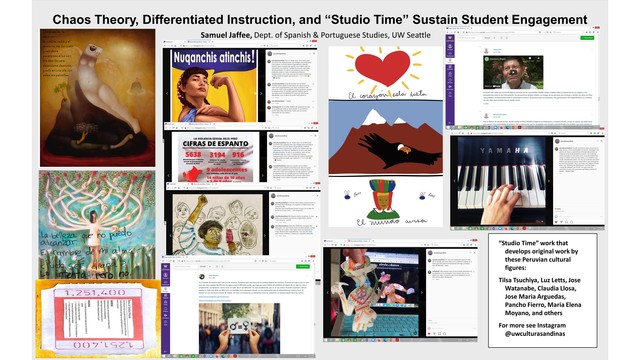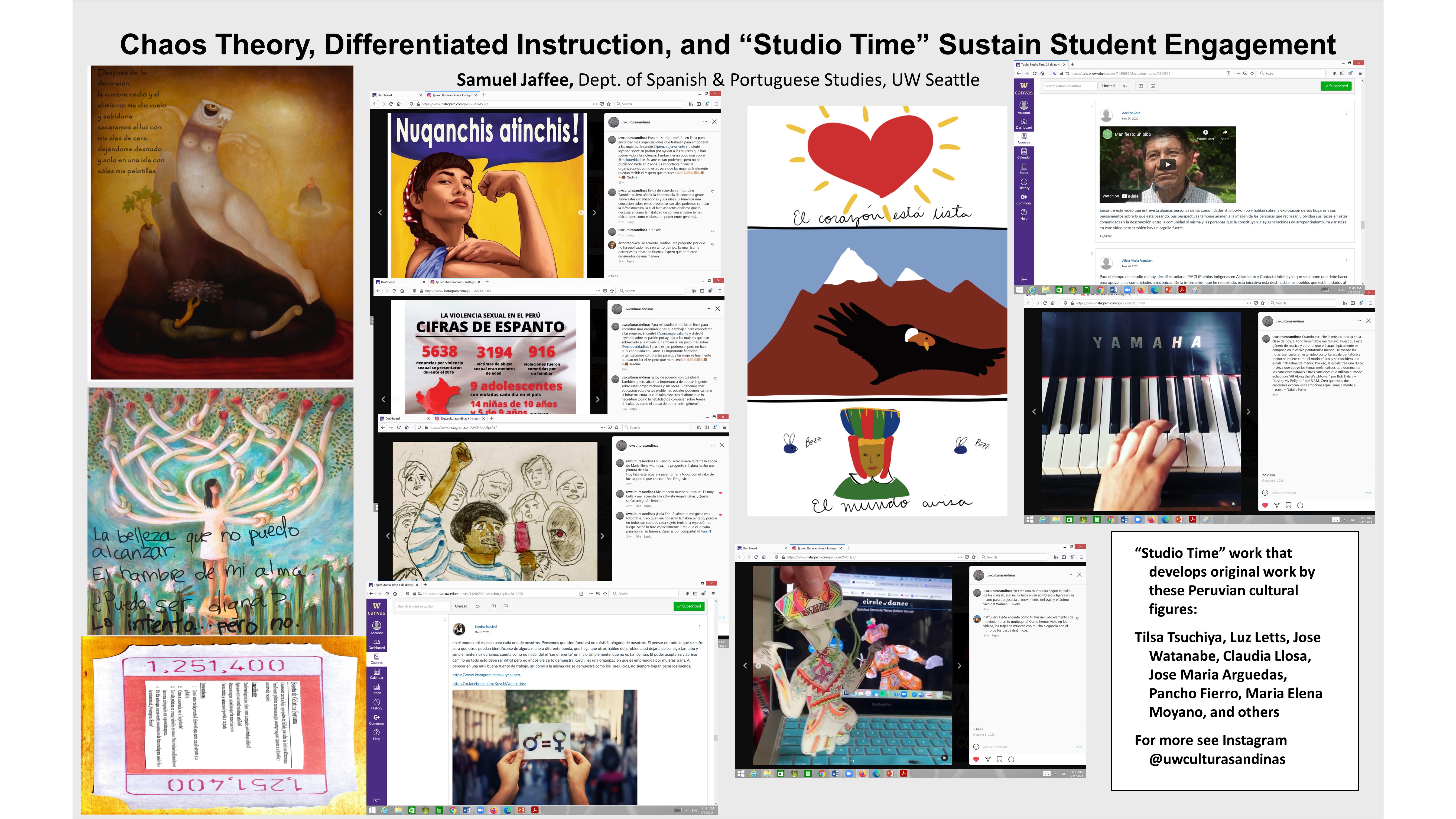Skip to main contentResource added 
The course goal is understanding how ethnicity, religion, gender, social class, and other identities are expressed in 20th-21st century Peru. As a differentiated and then interactive assessment, students engage in “studio time”—a period of 45 minutes during each meeting for responding to, reimagining, questioning, or researching the figures studied, going off on a tangent, and then presenting individual “studio” work to the class using Canvas or Instagram. The course is inspired by Diane Larsen-Freeman (Michigan), Richard Kern (Berkeley), Robert Blake (UC Davis) and Tim Rollins (artist), who promote the creative teaching of writing, literature, art, and culture—in person or digitally. I present some multidisciplinary “studio time” projects that students teach to their classmates (and instructor), reinforcing all of our learning and showing new perspectives on the course material. Examples include interactive websites, poetic memoirs, and philosophical collages. Students enter into tangible engagement with global cultures and increase their capacity to consider humanistic themes. Such goals can be implemented in introductory or advanced humanities courses, ideally discussion-based and with under 30 students, whether majors or non-majors. My experience teaching cultural studies at UW as “chaos/ complexity theory” shows that such courses appeal to a student body with a range of literacy skills, give students new ways of creative analysis, and may inspire students to choose a major in the discipline.
Chaos/Complexity Theory, Differentiated Instruction, and “Studio Time” Sustain Student Engagement

Full description
Video Presentation
Author:
Samuel Jaffee, Spanish & Portuguese Studies, UW SeattleAbstract:
I share my experience teaching a new course on Peruvian cultural studies to a class of 23 native, heritage, and second-language Spanish speakers (double majors in Spanish and another discipline), in a distance learning format, in Autumn Quarter 2020. I describe how chaos/complexity theory and differentiated instruction (organizing principles of variable tasks, teamwork, and student freedom), make the course accessible to students with a range of learning needs, support inquiry-based practical activities (formative and summative assessments), and clarify learning objectives.The course goal is understanding how ethnicity, religion, gender, social class, and other identities are expressed in 20th-21st century Peru. As a differentiated and then interactive assessment, students engage in “studio time”—a period of 45 minutes during each meeting for responding to, reimagining, questioning, or researching the figures studied, going off on a tangent, and then presenting individual “studio” work to the class using Canvas or Instagram. The course is inspired by Diane Larsen-Freeman (Michigan), Richard Kern (Berkeley), Robert Blake (UC Davis) and Tim Rollins (artist), who promote the creative teaching of writing, literature, art, and culture—in person or digitally. I present some multidisciplinary “studio time” projects that students teach to their classmates (and instructor), reinforcing all of our learning and showing new perspectives on the course material. Examples include interactive websites, poetic memoirs, and philosophical collages. Students enter into tangible engagement with global cultures and increase their capacity to consider humanistic themes. Such goals can be implemented in introductory or advanced humanities courses, ideally discussion-based and with under 30 students, whether majors or non-majors. My experience teaching cultural studies at UW as “chaos/ complexity theory” shows that such courses appeal to a student body with a range of literacy skills, give students new ways of creative analysis, and may inspire students to choose a major in the discipline.
Poster PDF
View a PDF version of the poster in Google Drive to enlarge the image or download a copy.
Comments
The presenter for this poster will be available to respond to comments during Poster Session 2 on April 20, 3:45-4:30 p.m.Comments
to view and add comments.
Annotations
No one has annotated a text with this resource yet.
- typeImage
- created on
- file formatjpg
- file size2 MB
- publisherUniversity of Washington
- rights


